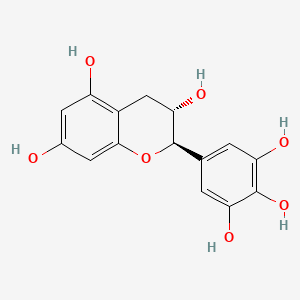| MeSH term | MeSH ID | Detail |
|---|---|---|
| Hemolysis | D006461 | 131 associated lipids |
| Adenocarcinoma | D000230 | 166 associated lipids |
| Lung Neoplasms | D008175 | 171 associated lipids |
| Reperfusion Injury | D015427 | 65 associated lipids |
| Colonic Neoplasms | D003110 | 161 associated lipids |
| Sarcoma 180 | D012510 | 21 associated lipids |
| Body Weight | D001835 | 333 associated lipids |
| Edema | D004487 | 152 associated lipids |
| Precancerous Conditions | D011230 | 48 associated lipids |
| Liver Diseases | D008107 | 31 associated lipids |
Gallocatechin
(+)-gallocatechin is a lipid of Polyketides (PK) class. The involved functions are known as inhibitors and Cell Survival. The associated genes with (+)-Gallocatechin are TERT gene.
Cross Reference
Introduction
To understand associated biological information of Gallocatechin, we collected biological information of abnormalities, associated pathways, cellular/molecular locations, biological functions, related genes/proteins, lipids and common seen animal/experimental models with organized paragraphs from literatures.
What diseases are associated with Gallocatechin?
Gallocatechin is suspected in Hyperinsulinism, nervous system disorder, Obesity, Parkinson Disease, Transient ischemia and other diseases in descending order of the highest number of associated sentences.
Related references are mostly published in these journals:
| Disease | Cross reference | Weighted score | Related literature |
|---|
Possible diseases from mapped MeSH terms on references
We collected disease MeSH terms mapped to the references associated with Gallocatechin
PubChem Associated disorders and diseases
What pathways are associated with Gallocatechin
There are no associated biomedical information in the current reference collection.
PubChem Biomolecular Interactions and Pathways
Link to PubChem Biomolecular Interactions and PathwaysWhat cellular locations are associated with Gallocatechin?
Visualization in cellular structure
Associated locations are in red color. Not associated locations are in black.
Related references are published most in these journals:
| Location | Cross reference | Weighted score | Related literatures |
|---|
What functions are associated with Gallocatechin?
Related references are published most in these journals:
| Function | Cross reference | Weighted score | Related literatures |
|---|
What lipids are associated with Gallocatechin?
Related references are published most in these journals:
| Lipid concept | Cross reference | Weighted score | Related literatures |
|---|
What genes are associated with Gallocatechin?
Related references are published most in these journals:
- Drug Metab. Dispos. (4)
- Cancer Epidemiol. Biomarkers Prev. (2)
- Am. J. Physiol., Cell Physiol. (1)
- Others (7)
| Gene | Cross reference | Weighted score | Related literatures |
|---|
What common seen animal models are associated with Gallocatechin?
Transgenic Model
Transgenic Model are used in the study 'Dietary (-)-epicatechin as a potent inhibitor of βγ-secretase amyloid precursor protein processing.' (Cox CJ et al., 2015).
Rodent Model
Rodent Model are used in the study 'Dietary (-)-epicatechin as a potent inhibitor of βγ-secretase amyloid precursor protein processing.' (Cox CJ et al., 2015).
Related references are published most in these journals:
| Model | Cross reference | Weighted score | Related literatures |
|---|
NCBI Entrez Crosslinks
All references with Gallocatechin
Download all related citations| Authors | Title | Published | Journal | PubMed Link |
|---|---|---|---|---|
| Erickson AJ et al. | Nitrification inhibitors from the roots of Leucaena leucocephala. | 2000 | J. Agric. Food Chem. | pmid:11312789 |
| Zhu M et al. | Pharmacokinetics and system linearity of tea catechins in rat. | 2001 | Xenobiotica | pmid:11334265 |
| Katiyar SK and Elmets CA | Green tea polyphenolic antioxidants and skin photoprotection (Review). | 2001 | Int. J. Oncol. | pmid:11351267 |
| Smith DM and Dou QP | Green tea polyphenol epigallocatechin inhibits DNA replication and consequently induces leukemia cell apoptosis. | 2001 | Int. J. Mol. Med. | pmid:11351279 |
| Meng X et al. | Formation and identification of 4'-O-methyl-(-)-epigallocatechin in humans. | 2001 | Drug Metab. Dispos. | pmid:11353745 |
| Bertoldi M et al. | Green tea polyphenols: novel irreversible inhibitors of dopa decarboxylase. | 2001 | Biochem. Biophys. Res. Commun. | pmid:11374875 |
| Warden BA et al. | Catechins are bioavailable in men and women drinking black tea throughout the day. | 2001 | J. Nutr. | pmid:11385060 |
| Muto S et al. | Inhibition by green tea catechins of metabolic activation of procarcinogens by human cytochrome P450. | 2001 | Mutat. Res. | pmid:11470492 |
| Yoshioka H et al. | Spin-trapping study on the hydroxyl radical formed from a tea catechin-Cu(II) system. | 2001 | Biosci. Biotechnol. Biochem. | pmid:11577706 |
| Zhang L et al. | [Studies on tannins from Tripterygium hypoglaucum (lévl.) hutch]. | 1998 | Zhongguo Zhong Yao Za Zhi | pmid:11599388 |
